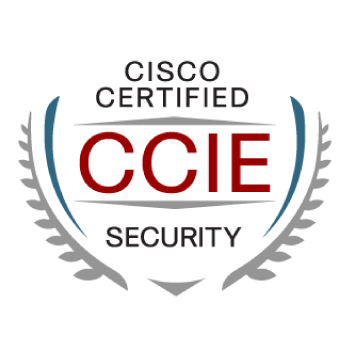Secutiry

CCNA Security Curriculum plan
CCNA Security introduction
the basic security theory introduction
the attack method introduction
self-defending network presentation
IOS Login Security Features
configure AAA
how to protect the security of the router
how to protect layer 2 security
how to protect endpoint security
how to protect voice security
IOS security classic feature
Cisco IOS Classic Firewall Introduction
Cisco IOS Zone-Based Firewall Introduction
VPN basic theory, Configure L2L VPN configuration using CLI/SDM
CCNP Security Curriculum plan
Cisco Firewall
Cisco ASA technology and features introduced
Cisco ASA product family introduced
Using the Cisco ASDM configuration interface, static routing and management access
Access control and policy-based Cut-Through Proxy
Deploy NAT
ASA virtualization features and high availability (FO)
IOS Security
- Deploy network infrastructure, protection, and control
- Deploy data security controls in advanced-level dada exchange
- Implementing Cisco Identity-based network services
- Deploy 802.1X basic characteristics
- Deploy advanced router data level security controls
- Deploy advanced control level security controls
- Deploy advanced management level security controls
- Deploy Cisco IOS software NAT
- Deploy basic ZBF
- Deploy Advanced ZBF
- Deploy Cisco IOS Software IPS
- Site-to-site VPN architecture and technology
- Deploy VTI site-to-site IPsec VPN
- Deploy scalable authentication in site-to-site IPsec VPN
- Deploy DMVPNs
- Deploy high-availability in tunnel-based IPsec VPN
- Deploy GET VPN
- Remote access VPN architecture and technology
- Deploy SSLVPN remote access solutions
- Deploy Remote Access Solution Using the Cisco Easy VPN
- ISE
VPN
- L2LVPN Advanced Features
- IPSec VPN network traversal issues and high-availability technologies
- Traditional VPDN Technology
- DMVPN
- GETVPN
- EZVPN
- SSLVPN
- FlexVPN and IKE v2
- Anyconnect 3.0 ASA VPN with advanced features
IPS
- IPS Introduction
- Evaluate traffic analysis of network IPS, the possibility of escape and evadecountermeasures: Network IPS and IDS’s deployment architecture
- Integrate Cisco IPS sensors into a network
- Cisco IPS sensors to perform the initial setup
- Manage Cisco IPS Device
- Configure basic traffic analysis
- Implement Cisco IPS signature code and respond to respond
- Configure Cisco IPS feature code engine and feature code database
- Deploy abnormal operation
- Customized traffic analysis
- Management of false positives and false negatives
- Improve the quality and responsiveness of alarm
- Install and integrate Cisco IME with Cisco IPS Sensor
- The Cisco IME manage and investigate incidents
- Cisco IME reports and notifications
- Integrate Cisco IPS and Cisco Security Manager and Cisco Security MARS
- Use Cisco IntelliShield databases and services
- Use Cisco IPS virtual sensors
- Configure high availability and performance of the Cisco IPS
- Configure and maintain Cisco ASA AIP SSM and AIP SSC Modules
- Configure and maintain Cisco ISR IPS AIM and IPS NME
- Configure and maintain Cisco IDSM-2
CCIE Security Curriculum plan
IGP
Switch
ASA
AAA
The network attack
Safety Feature
IPS
IOS Firewall
BGP
Deploy VPN
Router Safety management SSH / https / syslog / snmpv3 / ntpv3
Network attacks and mitigate means in Layer 2 device (including VLAN confusion, STPattack, ARP spoofing, MAC spoofing, CAM overflow)
Switch security technology (IBNS, PVLAN, SPAN port)
ISE deployment and high availability
COMBO PROGRAMS
Cisco Network Engineer (Security)

CCNA+CCNP
This Seminar includes two parts:
1. CCNA Security Training;
2. CCNP Security Training.
Cisco Internet Expert (Security)

CCNA+CCNP+CCIE
This Seminar includes three parts:
1. CCNA Security Training;
2. CCNP Security Training;
3. CCIE Security Training.


